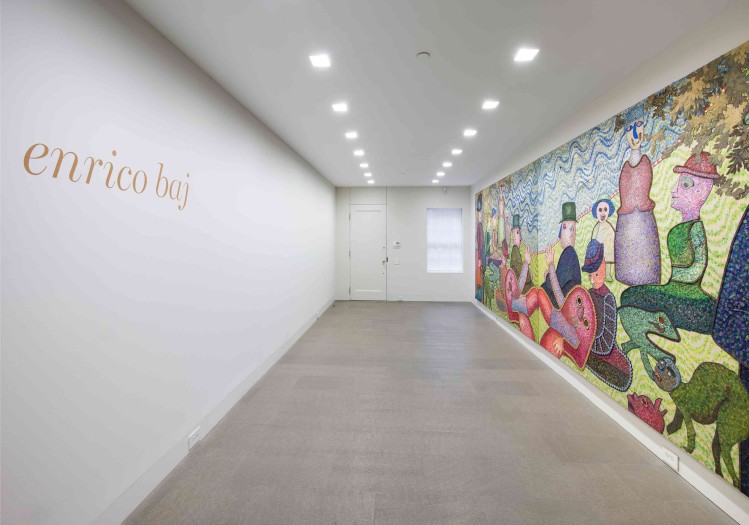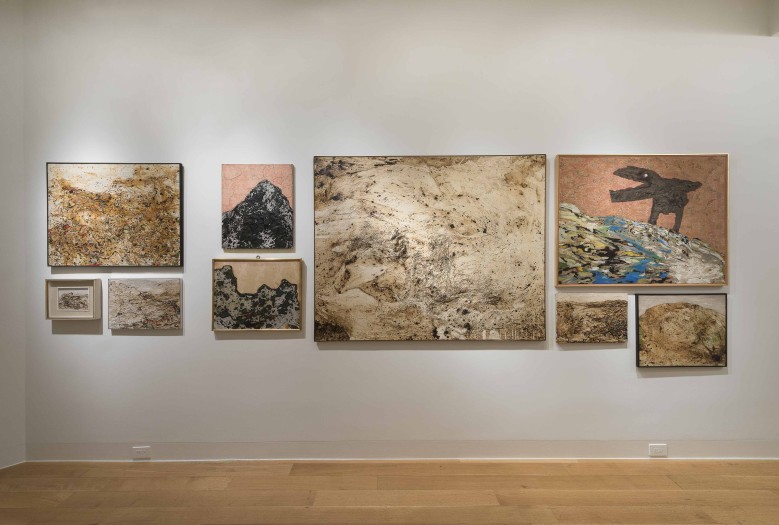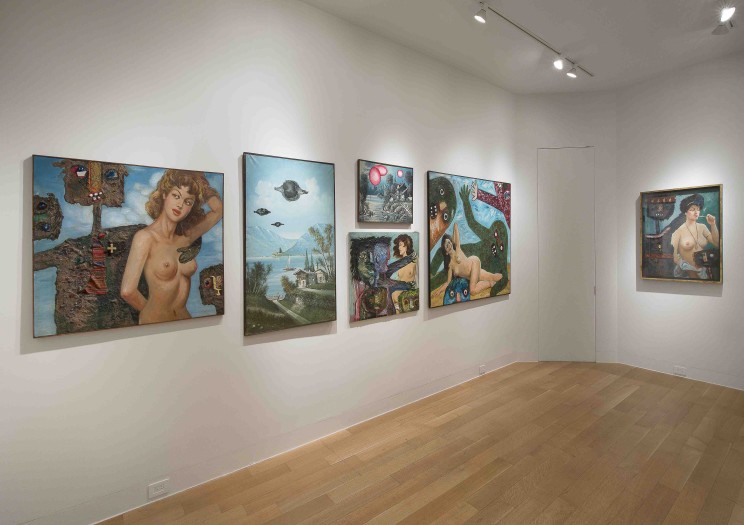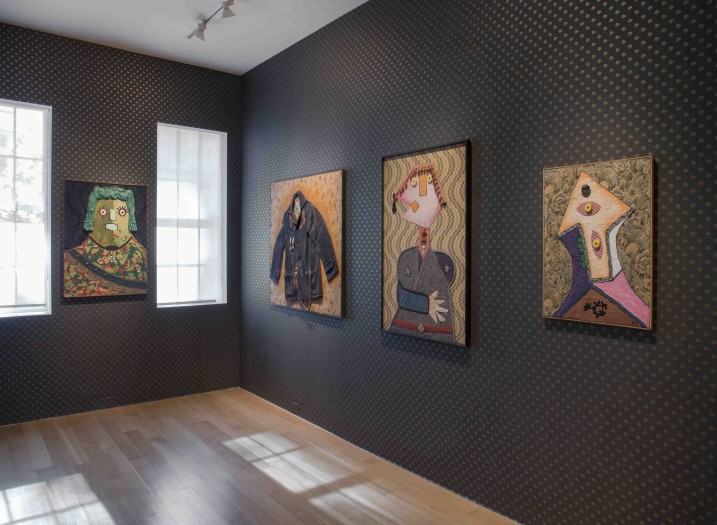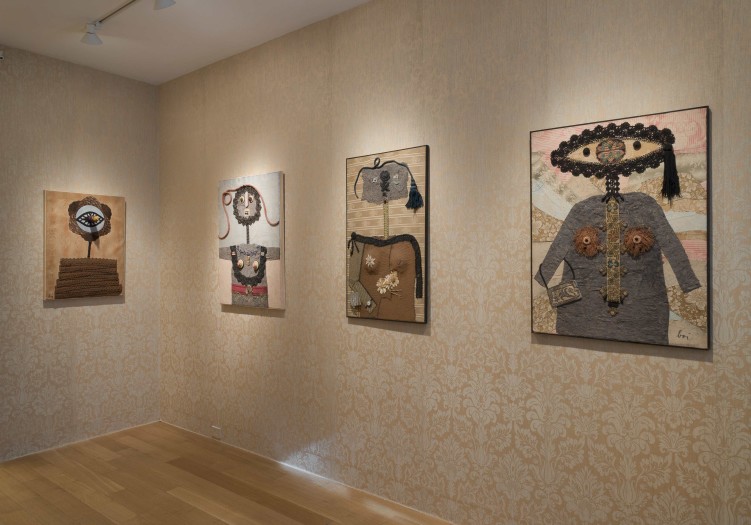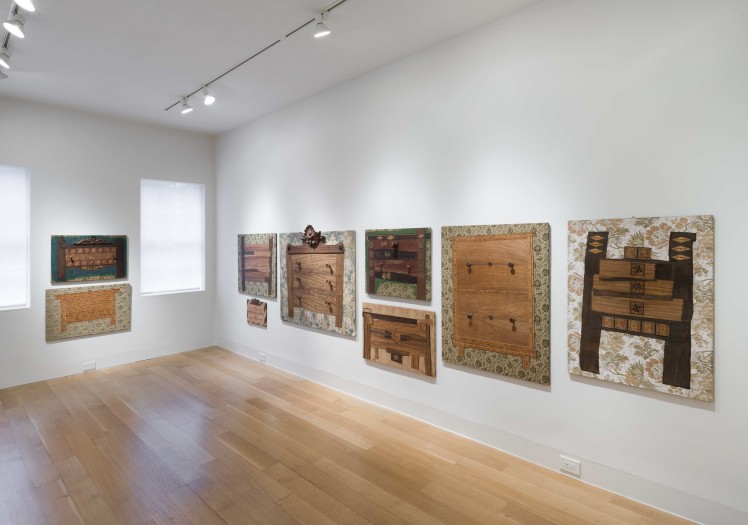Luxembourg & Dayan is pleased to present Enrico Baj, an exhibition of over fifty early paintings by one of the most bracing and contentious artists of the postwar period. With a passion for the eccentric and a wild iconoclastic impulse, Enrico Baj (1924-2003) was a central figure of the Italian neo-avant garde. His art and his political writings have played an instrumental role in the chronologies of influential movements, from Dada and Surrealism to Art Informel and Cobra, as well as the Milanese movement of Nuclear Art, which he co-founded with Sergio Dangelo. Throughout it all, Baj forged an idiosyncratic iconography that was all his own. Departing from gestural abstraction in the mid-1950s, he honed a painterly practice that defiantly embraced figuration and kitsch symbols, subverting authoritative, bourgeois conventions of “good taste.”
On view through December 23rd, Enrico Baj offers the first American survey of Baj’s early paintings since his exhibition at the Museum of Contemporary Art, Chicago, in 1971. Organized in close collaboration with the artist’s widow Roberta Cerini Baj, and longtime dealer Giorgio Marconi, the exhibition at Luxembourg & Dayan brings together key bodies of work that form the nucleus of Baj’s versatile yet highly recognizable oeuvre.
Among the exhibition’s highlights is The Double Grande Jatte (1971), a twenty-foot long mural that Baj created for his Chicago exhibition, and that is now presented to the public for the first time since its debut. Comprised of ribbons, ropes, buttons, and other accouterments on tapestry, this outrageous tableau simultaneously celebrates and denigrates Seurat’s masterpiece, reworking it into a poignant social commentary on the excesses of contemporary society and even the ultimate inflexibility of the artistic avant garde. The monumental work, with its cartoonish figures, encapsulates Baj’s satirical and potent form of collage.
In chronological terms, the departure point for Enrico Baj is Mountains (1957-1959), a series of paintings that feature patterned fabrics as skies. With their depiction of granular, mottled mountains, the works reflect the artist’s fascination with the splitting of matter and the breakdown of holistic nature in the atomic age. Following shortly after, the Modifications (1959-1960) emerged from Baj’s generative dialogue with Cobra artist Asger Jorn. Using thrift-store paintings of pastoral landscapes and voluptuous nudes as a basis for these works, Baj performed a détournement by adding his own garish figures (which he referred to as Ultra Bodies), flying saucers, and other figments of science fiction.
Other series in the exhibition unfold from 1960 onwards. This was a pivotal year for Baj, one that saw him embarking upon new artistic fronts, pushing the possibilities of incorporating found objects into the realm of painting. Baj was lauded for his portraits of Generals, crude, brutish figures adorned with ribbons and army decorations that offer a farcical commentary on the corruptive effects of power. An equally potent counterpart to this series is Baj’s Ladies, portraits of female personages who, ensconced in textiles, patterned wallpapers, and shreds of lush upholstery, evoked a defunct aristocracy. The Generals and Ladies became mainstays in Baj’s vocabulary over the following two decades. At Luxembourg & Dayan, these works will be presented in rooms papered with extravagant patterned wallpapers. Together with the dense hanging of other gallery rooms, this installation evokes the atmosphere of Baj’s villa in Vergiate, Italy – a house that became the artist’s ultimate gesamtkunstwerk, a world of pattern, art, collections, and crafts that embodied his irreverent vision of the world.
Also included in Enrico Baj are the ultra-flat Furniture paintings (1960-61), collaged works that mimic period design pieces and are created from actual scraps of furniture. The mood of innocent nostalgia conjured by these paintings remains merely on the surface: For Baj, the Furniture series was linked to the underlying atmosphere of anxiety captured in his earlier depictions of humanoids and alien invaders. As Surrealist writer André Breton remarked: “…the ‘period furniture’ shows the extent to which the enemy is capable of infiltrating the comfort of our homes, our ‘easy chairs’ and ‘lounges,’ which mold him and conceal him… What a flagrant invasion of our intimate existence!”
Exuberant yet riddled with deep-seated angst, Enrico Baj’s paintings capture the spirit of an artist who championed freedom above all else. To this day, they convey with fresh relevance Baj's steadfast belief in the agency of painting to raise new political awareness.
ABOUT THE ARTIST
Born in Milan, Italy, Enrico Baj (1924-2003) began studying at the Brera Academy of Art in 1938, only to flee to Geneva six years later in order to avoid conscription to the Italian army under Mussolini. Returning to Italy after the war, Baj pursued law studies, which he duly abandoned, becoming instead a mainstay in the Milanese avant garde art scene by the mid-1950s. Baj had his debut in New York in 1960, as part of the exhibition Surrealist Intrusion in the Enchanters’ Domain, organized by Marcel Duchamp and André Breton at D’Arcy Galleries. The following year, his work was included in the influential exhibition Art of Assemblage (1961), organized by William Seitz at the Museum of Modern Art, New York. In 1964 a room devoted to Baj’s work was presented in the 22nd Venice Biennial, and three major retrospectives followed in 1971, held at Palazzo Grassi, Venice; Museum of Contemporary Art, Chicago; and Musée de l’Athénée, Geneva. Recent exhibitions were held in the following venues, among others: Palazzo delle Esposizioni, Rome (2001-2002); the 55th Venice Biennial (2013), and Fondazione Arnaldo Pomodoro, Milan (2013).

